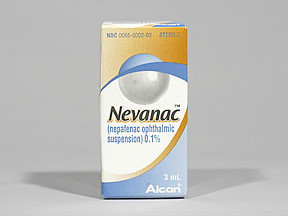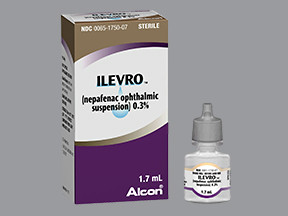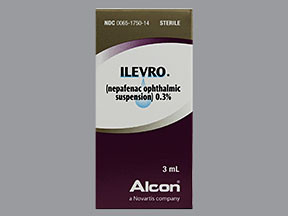NEPAFENAC SUSPENSION - OPHTHALMIC
PHONETIC PRONUNCIATION: (ne-PA-fen-ak)
COMMON BRAND NAME(S): Ilevro, Nevanac
GENERIC NAME(S): nepafenac
Uses
USES: This medication is used to relieve eye pain, irritation, and redness following cataract eye surgery. Nepafenac belongs to a class of drugs known as nonsteroidal anti-inflammatory drugs (NSAIDs). It works by blocking certain natural substances (prostaglandins) in your body that cause pain and swelling.
How to use NEPAFENAC SUSPENSION - OPHTHALMIC
HOW TO USE: Apply this medication to the operated eye(s) as directed by your doctor. The instructions for use depend on the strength of the eye drops prescribed. Follow your doctor's instructions. If you are using nepafenac 0.1% eye drops, apply it usually 3 times daily starting 1 day before surgery, and continue use on the day of surgery and for 2 weeks after surgery, or as directed by your doctor. If you are using nepafenac 0.3% eye drops, apply it usually once daily starting 1 day before surgery, and continue use on the day of surgery and for 2 weeks after surgery, or as directed by your doctor. Your doctor may also instruct you to apply an additional drop one-half hour to 2 hours before surgery. To apply eye drops, wash your hands first. Shake the bottle well before each dose. To avoid contamination, do not touch the dropper tip or let it touch your eye or any other surface. This medication should not be used while wearing contact lenses. Consult your doctor or pharmacist for details. Tilt your head back, look upward, and gently pull down the lower eyelid to make a pouch. Hold the dropper directly over your eye and place one drop into the pouch. Look downward and gently close your eyes for 1 to 2 minutes. Try not to blink and do not rub your eye. Repeat these steps for your other eye if so directed. Do not rinse the dropper. Replace the dropper cap after each use. If you are using another kind of eye medication (e.g., drops or ointments), wait at least 5 minutes before applying other medications. Use eye drops before eye ointments to allow the eye drops to enter the eye. This medication is usually used for up to 14 days after eye surgery or as directed by your doctor. Do not start using this medication early, use it more often than prescribed, or continue using it for longer than directed by your doctor. Prolonged use of nepafenac eye drops (more than 2 weeks) may increase the risk of very serious side effects of the eye. Inform your doctor if your condition persists or worsens.
Side Effects
Precautions
Interactions
Overdose
Images
Reviews
Faq for NEPAFENAC SUSPENSION - OPHTHALMIC
Nepafenac Suspension is used to treat pain and inflammation following cataract surgery.
Nepafenac Suspension works by reducing the production of certain substances in the eye that cause inflammation and pain.
Common side effects of Nepafenac Suspension may include blurred vision, eye irritation, redness, itching, or stinging/burning sensation in the eye.
You should follow the instructions provided by your doctor or pharmacist. Usually, Nepafenac Suspension is applied as one drop into the affected eye(s) three times daily beginning 1 day prior to cataract surgery, continuing on the day of surgery, and for two weeks following surgery.
You should avoid wearing contact lenses while using Nepafenac Suspension. Remove your contact lenses before applying the eye drops and wait at least 15 minutes before reinserting them.
The duration of treatment with Nepafenac Suspension is typically determined by your doctor. It is important to follow their instructions and complete the full course of treatment.
It is advisable to consult with your healthcare provider before using Nepafenac Suspension if you are pregnant or breastfeeding. They can evaluate the potential risks and benefits for you and your baby.
Nepafenac Suspension is generally not recommended for use in children. The safety and effectiveness of this medication in pediatric patients have not been established.
Nepafenac Suspension is specifically indicated for postoperative inflammation and pain following cataract surgery. It should not be used for other eye conditions without the guidance of a healthcare professional.
Disclaimer
IMPORTANT: HOW TO USE THIS INFORMATION: This is a summary and does NOT have all possible information about this product. This information does not assure that this product is safe, effective, or appropriate for you. This information is not individual medical advice and does not substitute for the advice of your health care professional. Always ask your health care professional for complete information about this product and your specific health needs.



No Reviews Yet